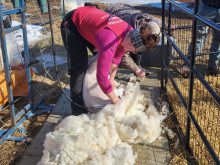REGINA – Interest in the goat business has gone from a ripple to a wave.
Easier to handle than a big milk cow, goats produce an alternative milk for those with allergies or a taste for something different. Soft cheeses like feta are also becoming more popular.
However, this new consumer interest leaves breeders scrambling to find enough milking does.
“There is quite an expansion in the dairy goat business for milk and milk products,” said Sandy LaRocque of Dauphin, Man.
She has gathered herds of dairy goats for export to Jamaica and Mexico. Demand is surging in Quebec.
Read Also

Charges laid after cattle theft
Saskatchewan RCMP lay two charges against a man after six cattle went missing.
“There are a lot of goats in Quebec and they need more,” she said.
Saanen and Alpine goats are most in demand.
LaRocque’s first order was 100 goats for Mexico. That buyer got her name via the internet from a breeder’s list. It took several months to find enough goats.
Western Canadian goats are bought for their quality. People are buying the animals as kids and will accept does up to five years of age. A goat is productive for about 11 years so buyers can expect at least another five years worth of milk from a five-year-old female.
Part of the market is connected to strong ethnic demand in large cities. Some new Canadians are accustomed to goat meat and milk. To fill their requests, Canada imports considerable amounts of goat meat every year.
People like LaRocque want Canadians to produce more to fill the domestic milk and meat market.
“Why should we import millions of pounds a year? We should not be importing as much as we do,” she said.
Goats are also gaining popularity in holistic grazing programs. They eat the plants cattle leave behind and the two species together can effectively clean up rangeland. A three-year grazing program in Brandon is using goats to control leafy spurge.
Industry growth delights Nola Rossow, secretary treasurer of the Saskatchewan Goat Breeders Association.
“People are finally realizing goats do have a place in our economy,” she said during the recent Canadian Western Agribition in Regina.
The challenge in the West is finding processors and getting a reasonable price for the milk. Prices vary from 56 cents a litre in Saskatchewan to 75 cents a litre in Alberta.
The growth trend has an interesting twist for the Canadian Goat Society in Ottawa.
Its membership has been stable but herd sizes are growing, said Sharon Hunt in Ottawa.
“Some had fewer than 20 whereas now 100 head herds are not uncommon,” she said. The largest herds are in Quebec, Ontario and Alberta.
More herds are reaching the 300- head mark where people have moved into serious dairy production to meet local demand.
“People are becoming more educated to the benefits of goat milk,” said Hunt.
For those entering the business or looking to expand, goat prices remain reasonable. Depending on quality and milking records, a doe is worth between $400 and $1,000 while bucks that are proven sires of good daughters start at $500.
“Prices are quite a bit lower than dairy cattle and there is no quota.”
According to the 1996 Statistics Canada census, there were 8,252 farms reporting a total of 125,819 goats.
Alberta reported 1,863 farms with 32,960 goats. Statistics Canada does not organize goat numbers by dairy, meat, fibre or other types.

















